|
The
Effect of Age on Color Memory
May 9, 2011 |
Abstract
The
purpose of this study is to investigate the effects of age on short-term
color memory using the method of successive color matching. A group of
11 college students with an average age of 20 was compared to a group of
experienced art dealers and collectors with an average age of 63. Using
24 hues of three cuts in three delay conditions, a total of 72 trials
were presented to each group. The results show that a delay condition
with verbal interference decreased the accuracy of response for both
populations, but proportionately more so for the student group. The
seniors performed overall less accurately than did the students across
colors and cuts, with the seniors exhibiting a significant decrease in
accuracy for the short wavelength colors, blue and purple. This suggests
that lenticular senescence is an important factor that influences which hues are most
easily remembered by senior subjects. Another implication of these
results is that color memory for the seniors is more contextual, also
involving material, surface texture, and patina.
Introduction
Success in
the art business, especially in the selling of colorful textiles,
paintings and objects, involves the ability to distinguish and remember
subtle color nuance. This ability, in the case of several of my
colleagues, is the result of decades of experience in handling art and
conveying to potential buyers the desirability of one color over
another. This acquired skill suggests that a testable difference might
exist between this particular group of experts and a similar number of
students, either trained or untrained in the arts.
Color
memory, or successive color matching, seemed an appropriate method to
measure possible differences between these two populations. Might the
years of experience mitigate the expected age-related losses in color
vision? In other words, would expertise trump physiology?
Experiments have shown that the ability to perceive and discriminate
colors most accurately is strongest between the ages of 16 and 35 (Lakowski,
1958). There is deterioration in the ability for fine color
discrimination after the age of 55, with more losses in the perception
of short wavelength blue light (Weale, 1973). With aging, the lens of
the eye undergoes crystalline yellowing, which effectively absorbs short
wavelength light, allowing fewer of these photons to hit the receptors
in the retina. The amount of blue light available to the retina of a 60
year-old is approximately one-third less than that present in the retina
of a 20 year-old. This shifts the sensitivity toward the longer
wavelengths for seniors (Weale, 1973). Lenticular senescence, another
term for this yellowing of the nucleus of the lens, was also shown by
Werner and Steele (1988) to significantly reduce perceptual sensitivity
to short wavelengths. A reduced amount of light entering the eye by
pupil constriction (senile miosis) further compromises color recognition
in the older eye (Weale, 1961). With these considerations, we expected
to find a difference in the performance of color memory by hue between
senior and student subjects.
Color
memory is also affected by how visual information is encoded. Two
theories (Paivio, 1969) (Baddlely and Hitch, 1974) suggest that two separate
mechanisms are used in short-term memory: perceptual and verbal. We
hypothesized that the seniors might have developed verbal descriptions
of colors that enable them to remember color nuance better than the
average person. In addition to the basic color terms proposed by Berlin
and Kay (1969) - black, white, red, green, blue, yellow, orange, brown,
purple, pink, and gray – other descriptors are used to differentiate
particular shades, such as navy blue and cherry red. Perhaps after years
of describing color, the senior group would more accurately cue their
short-term memory with verbal associations, increasing their rate of
accuracy.
This
experiment investigates the use of verbal cues by varying the delay
conditions on each trial, including one delay with verbal interference,
which should show an increase in errors of color memory. The effect of
age on color memory will be revealed by overall performance as well as
by the accuracy of remembering particular hues, particularly the short
wavelength blues and purples.
Methods
Participants
The participants
were eleven UC Berkeley students with a mean age of 20, and eleven
seniors with a mean age of 63. In the student group, nine of the
participants were female and two were male. In the senior group, five
were female and six were male. One of the male seniors reported a
perceived color deficiency, but tested as having normal color vision;
all other subjects in both groups had normal color vision. The student
subjects were enrolled in an extended course on color perception, they
participated voluntarily, and they served as subjects in several other
color experiments. The senior group was comprised of art dealers,
collectors, and artists who participated voluntarily, and had no other
recent testing experience.
Stimuli and Design
The design of this
experiment consisted of the independent combination of four factors: hue
(red, orange, yellow, chartreuse, green, cyan, blue, or purple), cut
(light, muted or dark), memory delay (0 or 6 seconds), and rehearsal
condition (counting or no-counting). In the 6-second delay condition
with counting, subjects counted backward by fives, starting with a
random two-digit number that was presented on the distracter slide. The
combination of three cuts and eight hues created 24 unique colors, shown
in Figure 1, equidistant from the central axis, which were then used in
each delay condition. The experiment, therefore, consisted of 72 trials
(24 colors x 3 delay conditions = 72 trials).
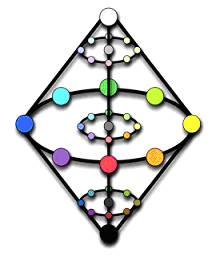
Figure 1. The Palmer
Lab color spindle. The three cuts used were light, muted, and dark,
all equidistant from the central axis. The saturated color cut was not
included.
The stimulus was a
square patch of color presented in the center of a neutral gray field,
with the trial number in the upper center margin of the screen, as shown
in Figure 2A. The 24 colors were combinations of the eight different
hues of medium saturation and three lightness conditions: light (high
lightness), muted (medium lightness), and dark (low lightness).
A
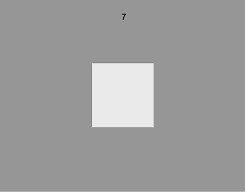 B
B
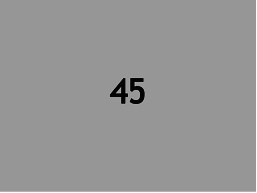
C
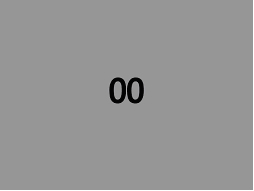 D
D
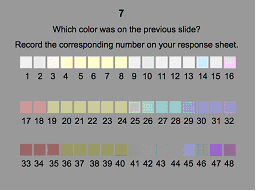
Figure 2: (A) An
example of a target stimulus that began each trial. (B) The mask that
appeared
during the 6-second delay condition with counting. (C) The 6-second
delay with no interference
mask. (D) The test array from which subjects made their response.
In the delay
condition, a neutral gray slide appeared with either a random number
from which to count backward by fives (Figure 2B), or two zeros, which
indicated a delay with no counting (Figure 2C). When there was no delay,
the test array appeared (Figure 2D). The test array was composed of
three rows of hues corresponding to the three cuts, with an intermediate
hue between each possible target hue. A number was placed beneath each
color square, from 1 to 48. The array was displayed for 15 seconds
during which time subjects were able to record their chosen response.
Apparatus
The visual
displays were presented using PowerPoint Mac 2008 on a Macintosh Air
computer that was connected to a Dell 4210X color projector. The
students recorded their responses on an Excel document on their personal
laptop computers, while the experts wrote their responses on printed
Excel documents.
Procedure
The participants
were seated in a darkened room with enough light to record their
responses. Subjects were instructed to look at the color patch on the
screen with the intent to remember it. After one second, the target
screen was replaced by a test array (in the no delay condition) or a
screen that presented one of two 6-second delay conditions: a pair of
numbers from which to count backward, out loud, by fives, or the numbers
00 on a gray screen, which indicated a delay with no counting. A screen
with a response array was then shown, from which subjects were asked to
choose the color patch that best fit the target color, and record the
associated number. Subjects were provided with four practice trials
before beginning the experiment to familiarize them with the different
delay conditions.
The students did
the experiment as a group during class time. The seniors met in the same
classroom on two different evenings, with one group of seven and another
of four. The total experiment took approximately 40 minutes per group.
Results
There was an
overall main effect in the delay type for both groups combined [F (2,
40) = 15.16, p < .001], as seen in Figure 3. The no delay and the delay
with no interference showed no significant difference in performance,
with both conditions resulting in slightly over 50% correct. The average
performance in the delay with no interference trials, however, was
significantly higher than in the delay with interference trials [t (21)
= 3.261, p < .005]. This suggests that by confounding the internal
verbal encoding of color names with a verbal distracter activity, color
memory can be disrupted.

Figure 3. The
average performance of all subjects in each delay condition shows the
decrease in performance with verbal interference.
When we
look at the delay conditions by group (Figure 4) we see that the
students performed better than the seniors in all three delay conditions
[F (2, 40) = 5.61, p < .01]. The difference in performance between
groups was similar in the two 6-second delay conditions, but diverged
significantly in the no delay trials, perhaps due to the rapidity with
which the response array appeared, resulting in confusion for the
seniors.

Figure
4. The average performance in each delay condition for students and
seniors shows better accuracy for the student group overall.
The
three-way ANOVA analysis of all subjects (Figure 5) shows a main effect
of hue [F (7, 140) = 11.02, p < .001]. These results show that all
subjects were most accurate in their response to the orange target
colors, verifying findings in a study done by Perez-Carpinell et al
(1998), which found that among ten colors studied, orange was the
easiest to remember. Both groups performed significantly less accurately
for the blue stimuli, an intriguing result, especially given that blue
was demonstrated to be the preferred color in a recent study by Palmer
and Schloss (2010). One possible explanation is that blue has only one
basic color term, as opposed to red, which enjoys two: red and pink.
This could affect the internal verbal coding, producing less accuracy
for the blue trials (personal communication, Schloss 2011).

Figure
5. The average correct responses for each hue by group shows the
difference in accuracy
for the students and the seniors.
The performance of
each group (Figure 6) in a three-way ANOVA analysis shows significant
results [F (7, 140) = 2.99, p < .01]. Both groups were similarly
accurate for the orange and cyan targets, with the seniors performing
less accurately for each of the other six hues.

Figure 6. The
average correct responses for each hue by group shows the difference in
accuracy for the students and the seniors.
A three-way
ANOVA analysis of cut shows a main effect (Figure 7) for the average
performance of all subjects [F (2, 40) = 5.39, p < .01]. Subjects were
nearly equally accurate for the light and muted cuts, but declined in
accuracy for the dark cut [t
(21) = 2.695, p < .05].

Figure 7. Average
percent correct of all subjects over the three different stimulus cuts
shows a
decline in accuracy for the darker target colors.
In a three-way
ANOVA analysis of cut by group, as displayed in Figure 8, there are
significant differences [F 92, 40) = 27.78, p < .001]. Both seniors and
students were equally accurate during light cut trials, at about 50%
correct. The performance of the seniors deteriorated as the cut went
from light to muted [t
(10) = 2.653, p < .05] and further from muted to dark [t
(10) = 2.568, p < .05]. The students, however, increased in accuracy from
the light to medium cut, while decreasing only slightly from the muted
to dark cut.

Figure 8. The
average correct responses over delay conditions by group show parity in
the light cut with gradual divergence in the two groups toward the dark
cut.
Discussion
The results of
this experiment illustrate several important aspects of color memory,
the first of which is the critical role of verbal encoding. When a
verbal distracter was introduced into the delay condition, performance
decreased in both young and older subjects. It was hypothesized that
perhaps with expertise (even though the visual system is compromised by
age), the seniors would compensate by having a greater command over
associated verbal cues. The response accuracy of all participants was
affected by a confounding of the verbal coding of color names,
supporting the dual coding hypothesis.
Another aspect
addressed by this experiment concerned the effects of age on color
memory. With senile miosis lessening the amount of light that enters the
older eye, the luminance of the target colors is diminished, making the
darker cuts harder to distinguish. The fact that there was decreased
accuracy for the seniors in both the muted and dark cuts supports this
effect. The lenticular senescence that causes absorption of some of the
short wavelength light hitting the retina of an older eye is also
illustrated by the decreased accuracy for the seniors in both the blue
and purple hues.
A shortcoming of
this experiment that may have affected the seniors more than the
students was the absence of a laser sound cue that is often programmed
to signal the beginning of each trial. The seniors more often missed the
appearance of the target color because they were looking down at their
response sheets. Another problem voiced by the seniors that may have
affected their performance was the relative size of the target patch to
response patch, indicating that a better test for seniors might be
simultaneous color matching, where both stimuli are the same size. An
analysis of the different types of errors – vertically by cut or
horizontally by hue – would be illuminating, but was beyond the scope of
this experiment.
In summary, it
appears that when color is reduced to a patch of light with no
contextual information, the effect of age on color memory is
significant. The physiology of the visual system deteriorates with age,
and no amount of expertise can compensate in this particular
experimental paradigm.
References
Bodrogi,
P. & Tarczali, T. (no date). Investigation of human colour memory.
University of Veszprém, Department of Image Processing and
Neurocomputing
Burns, B. & Shepp, B. (1988).
Dimensional interactions and the structure of psychological space: The
representation of hue, saturation and brightness. Perception and
Psychophysics, 43 (5), 494-507.
Bynum, C., Epps,
H.E., & Kaya, N. (2006). Color memory of university students: influence
of color experience and color characteristic. College Student
Journal, December. http://findarticles.com/p/articles/mi_m0FCR/is_4_40/ai_n27094508/
Epps, H.E. & Kaya,
N. (2004). Color matching from memory.
AIC 2004 Color & Paints,
Interim Meeting of the International Color Association, Proceedings,
18-21.
Lakowski, R. (1958) Age and
Color Vision. Advanced Science: 15:231-236
Medin, D.L. et al. (2005)
Cognitive Psychology. Fourth Ed. Hoboken, NJ: Wiley & Sons, Inc.
Nguyen-Tri, D., Overbury, O., & Faubert, J. (2003). The Role of
Lenticular Senescence in Age-Related Color Vision Changes.
Investigative Ophthalmology & Visual Science, August 2003, Vol. 44,
No. 8, 3698-3703.
Palmer, S.
E. (1999). Vision Science: Photons to Phenomenology. Cambridge,
MA: MIT Press.
Palmer,
S.E., Schloss, K. (2010). An ecological valence theory of human color
preference. Procedings of the National Academy of Science, 107(19),
8877–8882.
Perez-Carpinelli,
J., Camps, V., Tottini, M., & Perez-Baylach, M. (2006). Color Memory in
Elderly Adults. COLOR Research and Application, 458-466.
Weale, R.A. (1973) Spectral sensitivity and visual pigment absorbance. Vision Research. Sep;13(9):1797-8.
Werner, J.S. & Steele, V.G. (1988) Sensitivity of human foveal color mechanisms throughout the life span.
JOSA A, Vol. 5, Issue 12, pp. 2122-2130
|